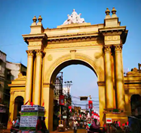‘Curzon Gate’ of Bardhaman & a Bit of History
- 20 Aug 2022
In West Bengal, the 119-year-old Curzon Gate in Bardhaman is currently in news after the ruling govt. of the state decided to erect statues of Maharaja Bijay Chand Mahatab and his wife Radharani in front of the Curzon Gate, one of the city’s major landmarks.

About Curzon Gate
- Maharaja Bijay Chand Mahatab built the gate when Curzon, who partitioned Bengal in 1905 and served as Viceroy of India, visited Bardhaman in 1903.
Some Facts about Bijay Chand Mahtab
- He was the ruler of Burdwan Estate, Bengal in British India (present-day West Bengal) from 1887 till his death in 1941.
- He and his family are known as makers of modern Burdwan.
- He was also the President of British Indian Association from 1911 to 1918 and again in 1925.
| British Indian Association
Indian Association
|
- In 1914, he was appointed as one of the members of the committee that investigated in to riots of Budge Budge and Komagata Maru incident.
- In 1938, he was a member of the Francis Floud Commission to suggest changes in the Permanent Settlement of 1793. The commission recommended the replacement of the zamindari system by a ryotwari (tenancy) system in which the ownership of land would vest with the ryot (tenant) and the land revenue payable by him could be revised periodically. The recommendations could not be implemented.




